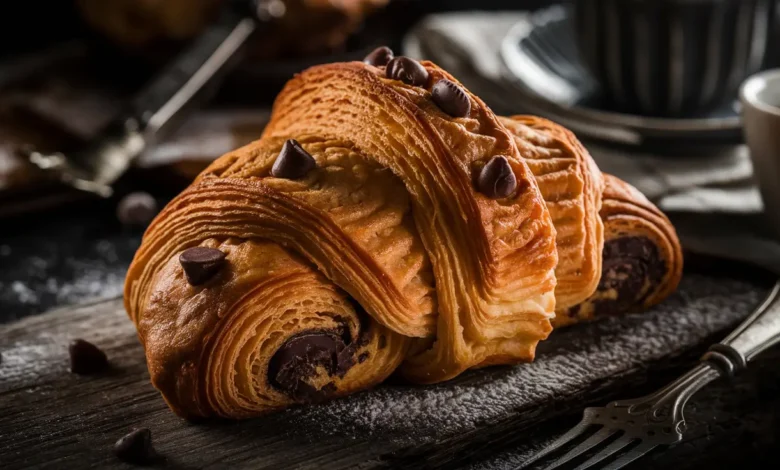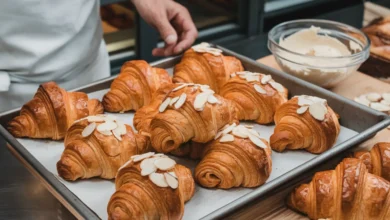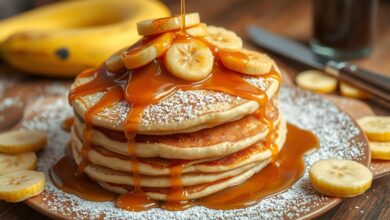Cookie Croissants: Where French Sophistication Meets Cookie Comfort

When French pastry precision meets American cookie comfort, magic happens in the form of Cookie Croissants. This innovative hybrid pastry has taken the culinary world by storm, combining the delicate, flaky layers of a traditional croissant with the sweet, indulgent appeal of beloved cookies. As a professional pastry chef, I’m excited to share the secrets behind creating these remarkable treats.
What Makes Cookie Croissants Special?
The genius of cookie croissants lies in their dual nature. The exterior maintains the signature flaky, buttery layers of a classic French croissant, while incorporating elements of cookie dough creates an entirely new texture and flavor profile. When baked, the cookie elements caramelize, creating pockets of sweetness throughout the pastry while maintaining the croissant’s delicate structure.
Essential Components
The Croissant Base
- 500g high-protein bread flour
- 60g granulated sugar
- 10g fine sea salt
- 14g active dry yeast
- 300ml cold whole milk
- 250g European-style butter (for lamination)
The Cookie Element
- 200g unsalted butter (room temperature)
- 180g light brown sugar
- 1 large egg
- 1 teaspoon vanilla extract
- 280g all-purpose flour
- ½ teaspoon salt
- 200g chocolate chips (optional)
The Art of Creation
Step 1: Croissant Dough Development
The foundation of a perfect cookie croissant begins with properly developed croissant dough. Mix the dry ingredients first, then gradually incorporate cold milk. The initial dough should be:
- Slightly firm but pliable
- Smooth in texture
- Not overly elastic
- Kept cold throughout the process
Step 2: The First Rest
After mixing:
- Shape into a rectangle
- Wrap tightly in plastic
- Refrigerate for 2 hours
- Maintain temperature between 38-40°F
Step 3: Cookie Layer Preparation
While the dough rests, prepare the cookie element:
- Cream butter and sugar until light
- Beat in egg and vanilla
- Mix in flour and salt
- Roll between parchment paper
- Chill until firm
Step 4: The Lamination Process
This crucial step requires precision:
- Roll croissant dough into a rectangle
- Place butter block in center
- Encase butter completely
- Perform three single folds
- Integrate cookie layer during final fold
Step 5: Final Shaping
The final shape determines the pastry’s appearance:
- Roll dough to 1/4 inch thickness
- Cut into triangles
- Stretch slightly
- Roll tightly
- Form into crescents
Baking Guidelines
Temperature Stages
Perfect baking requires three stages:
- Initial Blast: 400°F (200°C) for 5 minutes
- Main Bake: 375°F (190°C) for 15-18 minutes
- Finishing: 350°F (175°C) for 5-7 minutes
Visual Cues
Look for:
- Golden-brown exterior
- Visible layers
- Caramelized cookie edges
- Slight shine
- Firm structure
Professional Tips for Success
Temperature Control
Maintaining proper temperature is crucial:
- Keep dough cold (38-40°F)
- Work quickly during lamination
- Chill between folds
- Monitor oven temperature carefully
Texture Development
For perfect texture:
- Don’t overwork the dough
- Keep cookie layer thin
- Seal edges completely
- Allow proper proofing time
Common Pitfalls to Avoid
- Over-proofing
- Signs: Collapsed structure
- Prevention: Watch carefully
- Solution: Reduce proofing time
- Butter Leakage
- Signs: Pools of butter
- Prevention: Maintain temperature
- Solution: Work quickly
- Uneven Baking
- Signs: Inconsistent color
- Prevention: Proper spacing
- Solution: Rotate during baking
Creative Variations
Classic Chocolate Chip
The traditional favorite:
- Standard cookie dough
- Semi-sweet chocolate chips
- Vanilla-enhanced dough
- Sugar crystal finish
Double Chocolate
For chocolate lovers:
- Cocoa-enhanced dough
- Dark chocolate cookie layer
- Chocolate chip studded
- Chocolate glaze
Matcha Green Tea
An Asian fusion:
- Matcha in croissant dough
- White chocolate cookie layer
- Green tea glaze
- Gold leaf accent
Salted Caramel
Sweet and salty perfection:
- Caramel cookie integration
- Sea salt sprinkle
- Toffee bits
- Caramel drizzle
Storage and Service
Optimal Storage
For best results:
- Serve same day when possible
- Store at room temperature
- Avoid refrigeration
- Use airtight containers
Reheating Instructions
When needed:
- Preheat oven to 300°F
- Heat for 3-5 minutes
- Cool slightly
- Serve immediately
Professional Presentation
Casual Service
Perfect for bakery display:
- Kraft paper liner
- Light dusting of powdered sugar
- Simple garnish
- Natural presentation
Elegant Plating
For upscale service:
- White porcelain plate
- Fresh berries
- Quenelle of cream
- Sauce design
- Edible flowers
The Future of Cookie Croissants
As this hybrid pastry continues to evolve, we’re seeing exciting innovations:
- Seasonal variations
- Local ingredient adaptations
- Cultural fusion elements
- Health-conscious versions
Nutritional Considerations
Per serving:
- Calories: 380
- Fat: 22g
- Carbohydrates: 42g
- Protein: 6g
- Sugar: 18g
Conclusion
Cookie croissants represent the perfect marriage of French pastry expertise and beloved cookie comfort. Success lies in understanding the delicate balance between traditional croissant lamination and cookie integration. With proper technique, temperature control, and attention to detail, these pastries offer a unique and delightful addition to any bakery’s repertoire.
Whether you’re a professional baker or an ambitious home cook, mastering cookie croissants opens up a world of creative possibilities. The key is respecting the fundamental techniques while being open to innovation and experimentation. As this hybrid pastry continues to evolve, it stands as a testament to the endless possibilities in the world of pastry arts.
Remember, perfection comes with practice, and each batch is an opportunity to refine your technique. Start with the classic version, master the basics, and then let your creativity guide you toward new and exciting variations. Your customers or guests will appreciate the extra effort that goes into creating these unique and delicious pastries.




